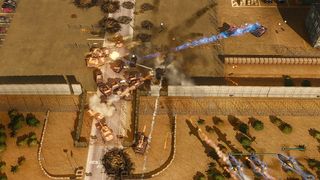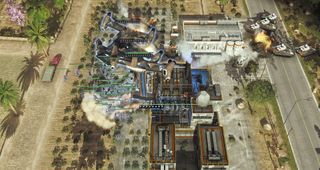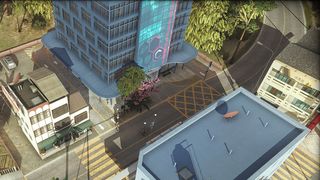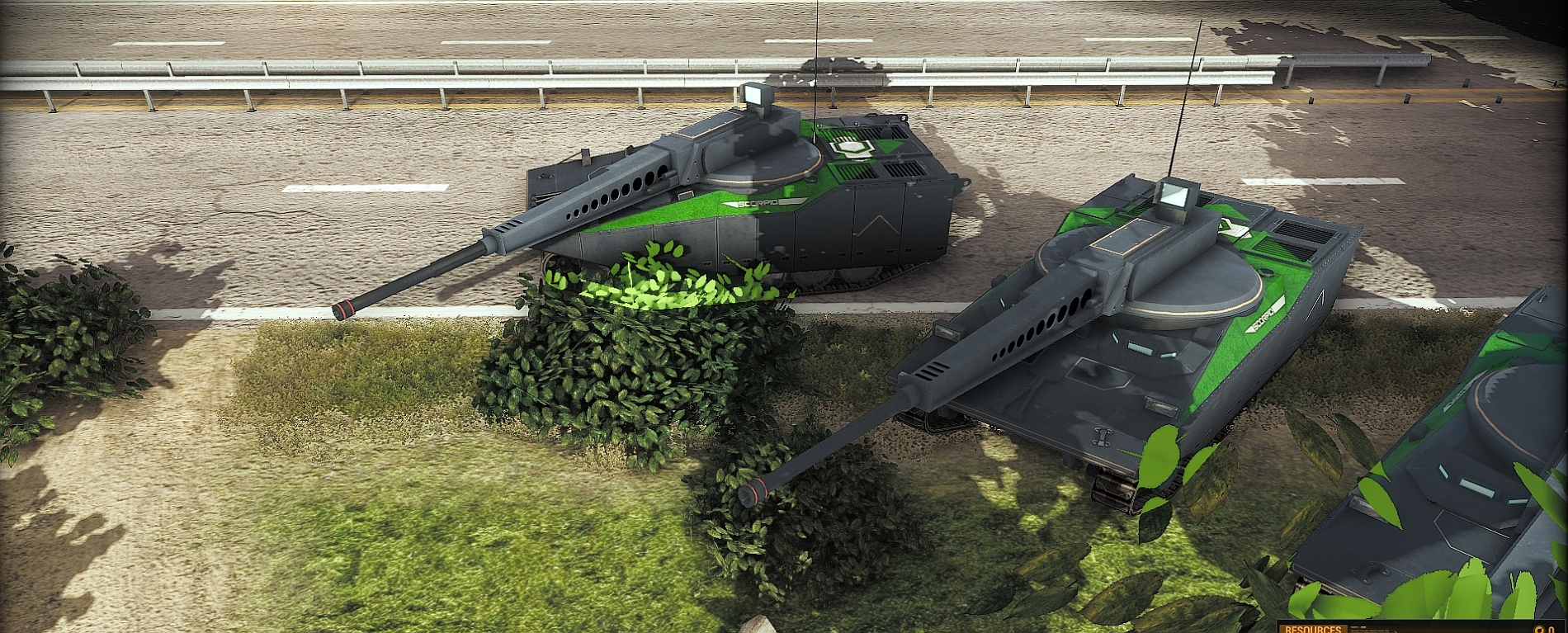Our Verdict
AI flaws and a limp campaign let down an otherwise-accomplished RTS revival.
PC Gamer's got your back
What Is It? Modern military RTS with an old-school sensibility.
Price: $45/£35
Release Date: Out now
Publisher: Focus Home Interactive
Developer: Eugen Systems
Multiplayer: Online, up to eight players
Link: Official site
Set during a near-future war, Act of Aggression is, nonetheless, a throwback—to Act of War, the mid-noughties RTS series that it succeeds, and to old-school base-building strategy games in general. Three factions—the UN-sponsored Chimera, the US Army, and a coalition of PMCs called the Cartel—battle over large maps to secure resources and assert military dominance. If you've missed heavy tanks and noodly electric guitar soundtracks—welcome home.
Command & Conquer: Generals is the obvious reference point, here, but Act of Aggression is very much its own game. Resources are distributed randomly across notably expansive maps, adding a speculative scouting phase to the start of every match that shapes your overall strategy. During this phase you construct refineries and set up supply lines, with each faction offering a slightly different set of parameters for handling conveyance, base expansion, power generation, and so on. It's a lot to take in, but if you've lamented the absence of this kind of RTS over the last few years then it's a difficulty curve you'll enjoy surmounting.

What follows is the drama of the match proper. An infantry battle might break out between garrisoned buildings for control of a bank which generates resources over time for the side that holds it. You might send a platoon of soldiers to capture downed enemy combatants for a bounty, or engage in a daring medivac mission to prevent the same from happening to your own troops. Tank columns roll through the countryside, helicopters clash in the air, jets soar in from off-map as each player approaches the point where they can deploy match-ending superweapons like nukes and long-range artillery. If you've played these types of games before you'll have an immediate sense of what units to expect and how they feel in combat: Act of Aggression doesn't offer anything particularly new in that regard, but there's pleasure in familiarity.
The campaign is a limp introduction to all of this, however. There are two sets of missions—one for Chimera, another for the Cartel—set in a homebrew Clancyverse that offers nothing you haven't seen in dozens of other modern warfare games. The writing and acting is poor and the game uses photography, news-report style visual effects and stock footage in place of cutscenes. Plot isn't very important to a game like this, but there's no C&C-style FMV scenery-chewing to motivate you, either.
The missions themselves follow an old, well-worn pattern. You start out ordering a gaggle of troops along a linear set of waypoints to learn the basics. The amount of freedom you're given increases with every mission until you start to approach full control. The issue is that, like in many older RTSes, your most dangerous foes are the scripted moments planned to occur as you hit checkpoints along the way. If you don't have the right force composition at these moments, you'll probably fail. This creates a frustrating trial-and-error dynamic where your first attempt is disproportionately hard (because you don't know what's coming) and your second is disproportionately easy (because you do.)

Reviewed on Intel Core i5 2500K, 16GB RAM, Nvidia GeForce GTX 970
Graphics options Window type, vsync, render reduction, shader/texture quality, texture anisotropy, shadow quality, model quality, tessellation, LOD transition, terrain and water quality, dynamic lighting and fx, HDR, motion blur, ambient occlusion, reflections, hardware instancing
Anti-aliasing 1X-8X MSAA
Remappable controls Yes
Act of Aggression ran well on a mixture of high and very high settings—steady 60fps with no noticable dips. I did hit a couple of problems when alt-tabbing, however, including the position of the mouse cursor falling out of sync with the game itself.
The game is at its best when every player adheres to the same set of rules and all of its systems are in play at once. For this reason I found skirmish matches to be a more entertaining way to learn Act of Aggression than the campaign. There are plenty of maps, varied options for AI difficulty and team composition, and lots of potential value in discovering all of these over time.
After several hours of one-on-one skirmishes, I thought I'd try something more challenging—a four player free-for-all. I wanted to see how the large maps and random placement of resources affected a more dynamic style of game. The match was interesting from the start: my initial location had lots of oil but little aluminium, so I opted for a low-tech build. Pushing out with large amounts of US infantry, I was able to cap a run of banks and fortify them with cheap MG emplacements. I waited for the moment when I'd run into resistance, fearing the high-tech arms that my missing aluminium supply might provide an enemy.
It wasn't to be. Eventually, I pushed out far enough to bump into my first enemy base. Three basic buildings were surrounded by a clump of infantry and light tanks, and that was it. As I was wiping them out, I realised that they hadn't built any resource extraction buildings. Then, as I encountered the other two factions, I discovered that they hadn't either. All of my early preparation was a complete waste of time, as none of the AI factions had done anything at all after their initial resources had run out. I like Act of Aggression and I'd be inclined to recommend it on the strength of skirmishes alone, but bugs like this mean I can't. I tried another FFA match without encountering the issue again, but the fact that it can happen at all is a disappointment.

The heart and future of the game will ultimately lie in multiplayer, which provides all of the options you remember: you can play against the AI, against each other, configure teams as you like and there's a ranked ladder if you'd like to take things more seriously. There's no LAN support, however, as all multiplayer is handled through online lobbies. Playing prior to the game's official release, it's tough to get a sense of how the scene will shake out—I had matches that came down to cheesy minute-zero building rushes (disappointing) and matches that played out over a full forty minutes with plenty of dramatic moments. As with any competitive game, I fully expect these experiences to shift as I become more experienced: these initial impressions represent the bottom of a long and often-unforgiving climb.
In order to get the most out of Act of Aggression you need to be able to put up with the campaign and the sometimes-severe rough edges. This isn't the complete package in the way that the old Westwood games were, or the way Blizzard's strategy games are. But moment to moment, in the little things that matter, it's a worthy successor to the games that inspired it.
AI flaws and a limp campaign let down an otherwise-accomplished RTS revival.
Joining in 2011, Chris made his start with PC Gamer turning beautiful trees into magazines, first as a writer and later as deputy editor. Once PCG's reluctant MMO champion , his discovery of Dota 2 in 2012 led him to much darker, stranger places. In 2015, Chris became the editor of PC Gamer Pro, overseeing our online coverage of competitive gaming and esports. He left in 2017, and can be now found making games and recording the Crate & Crowbar podcast.

Today's Wordle answer for Monday, November 18

Bioware's art lead shared some off-the-wall rejected concepts for Dragon Age: Inquisition's multiplayer characters, including the return of a controversial companion we never saw again

Yakuza/Like a Dragon creator Toshihiro Nagoshi says his studio's new game won't be that big after all: 'it's not modern to have similar experiences repeated over and over again'
